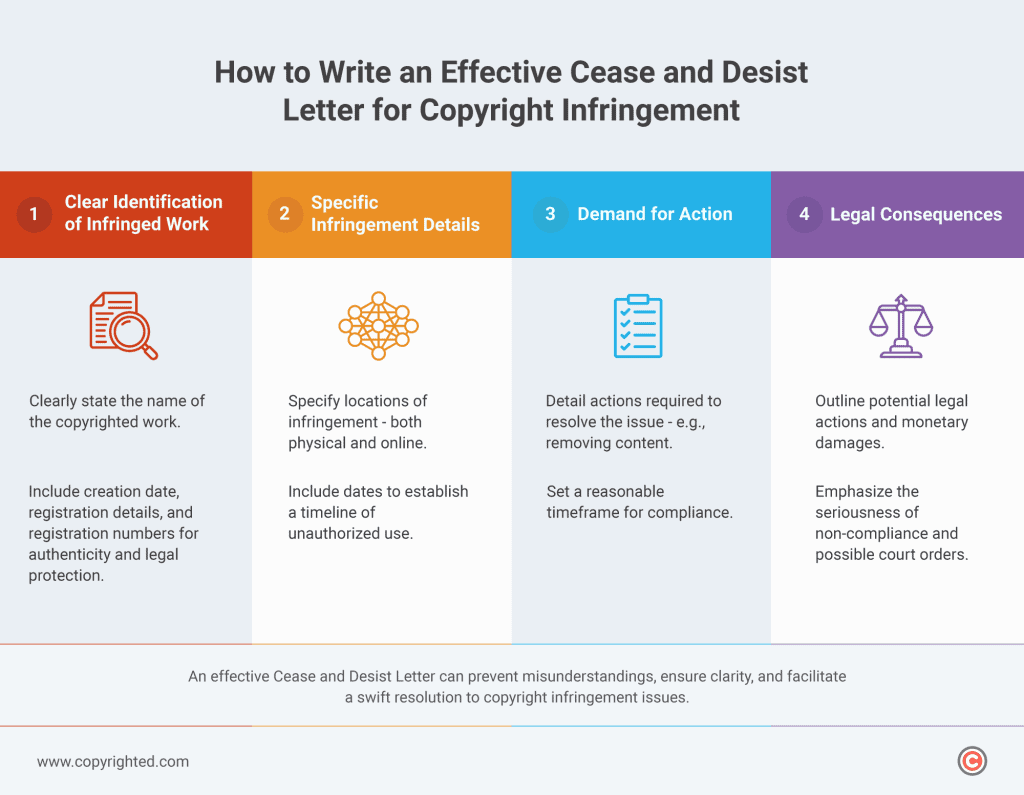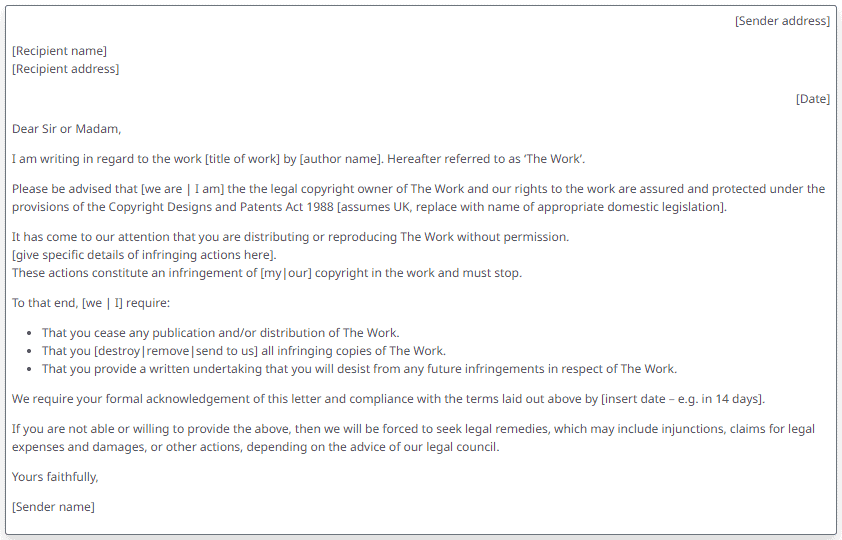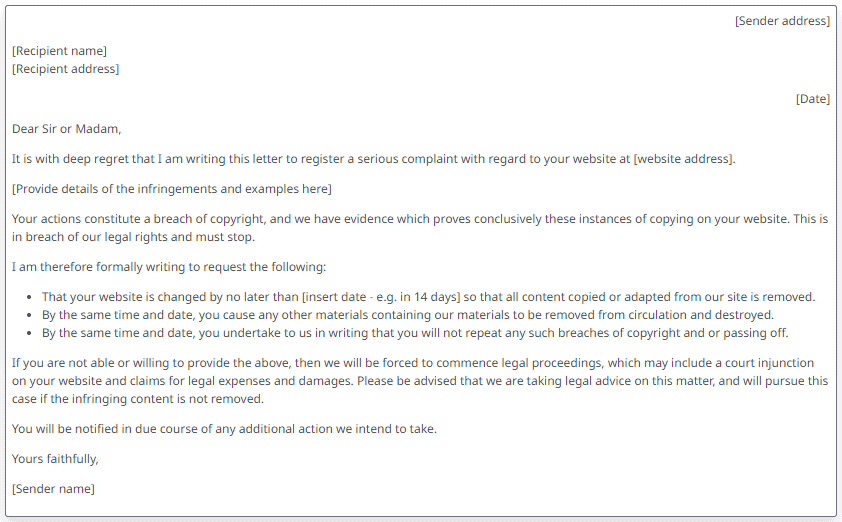Discovering that someone has used your original work without permission can be unsettling and frustrating. However, it’s important not to react impulsively, as hasty actions might not be in your best interest.
Instead, the initial and essential step is to compose and send a copyright infringement cease and desist letter.
This article aims to guide you through the process of crafting an effective cease and desist letter, outlining four key components that enhance its impact. Additionally, we’ll highlight its significance in a copyright infringement case and shed light on the subsequent steps that happen once you’ve sent it.
- A Cease and Desist Letter for Copyright Infringement is a formal way to notify, demand a stop, and warn of legal consequences for using copyrighted material without permission.
- Potential outcomes of sending a copyright cease and desist order include the recipient taking the letter seriously, responding to your letter, or ignoring your letter.
- A good copyright cease and desist letter should be clear, concise, and legally sound.
Table of Contents
What is a Copyright Infringement Cease and Desist Letter?
A Copyright Infringement Cease and Desist Letter is a formal written notice sent to an individual or entity suspected of using copyrighted material without permission. This letter serves as a warning and demands that the recipient cease the infringing activities.
The key elements typically included in such a letter begin with the identification of the copyright owner or their legal representative, such as providing their name and contact information. It then outlines the copyrighted material allegedly being infringed upon, which could include various forms of creative works such as text, images, music, videos, or software.
In addition, the letter may present evidence of the alleged infringement, such as URLs, publication dates, or other relevant information demonstrating the unauthorized use of the copyrighted material. The core purpose of the letter is to demand that the recipient immediately stop using the copyrighted material without proper authorization, often phrased as a cease and desist order.
Consequences of non-compliance are usually outlined in the letter, including potential legal action, monetary damages, and court proceedings.
A specified timeframe for compliance is also included, allowing the recipient a reasonable period to rectify the situation. The letter also provides contact information for the copyright owner or their legal representative, facilitating communication to address the issue.
While sending a Cease and Desist copyright infringement Letter is not a legal requirement, it is a common initial step in addressing copyright infringement.
It gives the alleged infringer an opportunity to voluntarily resolve the matter before potential legal action is pursued. Failure to comply with the cease and desist demand may lead the copyright owner to escalate the issue by filing a lawsuit in a court of law.
If copyrighted material is being used without authorization on digital platforms, sending a Digital Millennium Copyright Act (DMCA) Cease and Desist email is a necessary and recommended step.
It’s one practical way of learning how to notify someone of copyright infringement in a clear and actionable manner, ensuring there’s a documented record of the notice.
Like a cease and desist letter, the primary purpose of a DMCA cease and desist email is to inform the alleged infringer of the copyright violation and demand the immediate cessation of the infringing activities.
The email typically includes a clear identification of the copyrighted material being infringed, along with specific details about the infringement.
Similar to a traditional cease and desist letter, the DMCA email explicitly demands the infringing party to take immediate action. This could involve content removal, disabling access to the infringing material, or any other necessary steps to rectify the infringement.
What is the Purpose of a Copyright Infringement Cease and Desist Letter?
The main purpose of a Copyright Infringement Cease and Desist Letter is to formally notify an individual or entity suspected of unauthorized use of copyrighted material to immediately cease such activities or face potential legal consequences.
It functions as a formal and written warning, clearly communicating to the alleged infringer that their activities have been identified and are considered a violation of copyright law. It emphasizes the legal obligation to stop using the copyrighted material without proper authorization.
This aspect serves as an initial attempt to resolve the matter amicably and voluntarily, without resorting to immediate legal action.
How Do You Write an Effective Cease and Desist Letter?

When crafting a Cease and Desist Letter for copyright infringement, it’s essential to be clear and concise. This formal communication is a significant initial step in addressing the unauthorized use of copyrighted material.
Below are key elements to consider to create an impactful Cease and Desist Letter:
1. Clear Identification of Infringed Work
Start by clearly stating the name of the copyrighted work, making sure there’s no confusion about which work you’re referring to. Also, share relevant details like when it was created to show its originality and timeline.
If applicable, highlight the official registration details of the copyrighted work, such as registration numbers. This not only confirms your claim’s authenticity but also emphasizes the legal protections the work has under copyright law.
This clarity lays a strong foundation for your claim, preventing any misunderstandings. It gives the alleged infringer precise information about the specific work involved, ensuring they understand the nature of the alleged copyright violation.
2. Specific Infringement Details
This part involves presenting specific details that highlight the unauthorized use of the copyrighted material.
Begin by specifying information where the infringement is taking place. List the areas or online locations where the copyrighted material is being used without proper authorization.
This not only points out the specific instances of infringement but also helps the person understand the extent of the problem. If applicable, include dates when this infringement occurred.
Knowing when it happened helps establish a timeline, showing how long the unauthorized use has been going on. By giving these specific details, you offer the person a clear and concrete basis for your claim.
3. Demand for Action
Here, you need to tell them exactly what they need to do to fix the problem, like removing specific content or stopping the unauthorized use. Be clear and detailed about the actions you expect from them to resolve the copyright issue quickly.
It’s also important to set a reasonable timeframe for them to follow your requests. This timeframe should allow for a prompt response and corrective action.
Make sure the specified duration makes sense given the nature of the infringement and what needs to be done to fix it.
Doing so gives the recipient a clear plan to resolve the copyright violation. This clarity avoids confusion and provides a basis for a quick and friendly resolution.
4. Legal Consequences
It’s also important to state the possible legal outcomes if the recipient doesn’t comply with the copyright cease and desist letter demand. This includes mentioning the chance of legal action, like filing a lawsuit, to address the infringement and seek legal remedies under copyright law.
Also, emphasize the potential for monetary damages. Make it clear that continuing the unauthorized use of the copyrighted material may lead to financial consequences, such as compensating the copyright owner for any damages caused by the infringement.
Additionally, mention other solutions available under copyright law if compliance isn’t achieved. This might involve seeking injunctive relief, which could include court orders to stop the infringing activities.
By highlighting these potential legal consequences, the letter stresses the seriousness of the situation and the need for prompt compliance.
Why Do You Need to Send a Copyright Infringement Cease and Desist Letter?
A Copyright Infringement Cease and Desist Letter serves as a formal and essential communication tool in addressing the unauthorized use of copyrighted material. It holds significance due to various reasons integral to the copyright enforcement process.
Firstly, the letter acts as a notice to the alleged infringer, bringing their attention to the copyright owner’s claim of unauthorized use. By establishing this official record of communication, the letter initiates a structured and documented dialogue regarding the infringement.
Moreover, the cease and desist letter provides an opportunity for voluntary resolution before resorting to legal proceedings. By alerting the alleged infringer to the violation and offering a chance to rectify the situation, it encourages a faster and potentially more amicable resolution, sparing both parties from the complexities of a legal battle.
Knowing how to stop copyright infringement before it escalates into a court case is crucial, and issuing a cease and desist letter can be one of the most effective proactive measures to achieve that.
The letter also serves as legal documentation, demonstrating the copyright owner’s proactive efforts to address the infringement outside of court. If legal action becomes necessary, this documentation may play a key role in showing the copyright owner’s reasonable attempts to resolve the matter.
Clarity in claims is another important aspect addressed by the cease and desist letter.
By specifying the infringed work, detailing the nature of the infringement, and outlining the requested actions, the letter ensures an unambiguous understanding of the copyright owner’s assertions. This clarity lays the groundwork for a more straightforward resolution process.
Lastly, the letter emphasizes the potential legal consequences should the alleged infringer fail to comply with the cease and desist demand. By warning of legal actions, such as filing a lawsuit and seeking remedies available under copyright law, the letter acts as a deterrent, highlighting the gravity of the situation and encouraging prompt compliance.
In essence, a Copyright Infringement Cease and Desist Letter is an important and multifaceted tool that facilitates effective communication, encourages resolution, and establishes a clear foundation for further legal proceedings if necessary.
What Happens After You Send a Cease and Desist Letter for Copy Infringement?
After sending a Cease and Desist Letter for Copyright Infringement, potential outcomes include the recipient taking the letter seriously, responding to your letter, or ignoring your letter.
If the recipient takes the letter seriously, they may comply with the cease and desist demand.
This could involve removing the infringing content, discontinuing unauthorized use, or taking other corrective actions to address the copyright infringement. In such cases, the matter is resolved amicably, and legal action may not be necessary.
A responsive recipient may engage in communication to discuss the allegations, negotiate terms, or seek clarification.
This could lead to a resolution through mutual agreement, potentially involving licensing arrangements or other terms that address the copyright owner’s concerns. Open communication provides an opportunity for both parties to find a satisfactory resolution without escalating the situation.
If the recipient ignores the cease and desist letter, it may necessitate further legal action.
In this scenario, the copyright owner may choose to escalate the matter by filing a lawsuit. Legal proceedings could result in the enforcement of the cease and desist demand.
In summary, the outcomes following a Cease and Desist Letter depend on how the recipient responds. Cooperation can lead to a civil resolution, while communication may pave the way for negotiation.
Ignoring the letter may prompt legal action, where the copyright owner seeks remedies through the legal system to address the copyright infringement.
Good Examples of Cease and Desist Letters
A good copyright cease and desist letter should be clear, concise, and legally sound.
Below are examples of a good cease and desist letter:


Remember, each cease and desist letter should be customized to the specific circumstances of the infringement. It’s often advisable to seek legal advice or assistance in drafting the letter to ensure it is legally sound and effectively communicates your position.
Frequently Asked Questions
How serious is a cease and desist letter?
A cease and desist letter is a serious legal document that demands the recipient stop certain actions. It signals the intent to pursue legal action if the issues raised are not resolved promptly.
What happens if you ignore a cease and desist letter?
Ignoring a cease and desist letter may lead to legal consequences. The sender could pursue legal action, seeking remedies like injunctions or damages.
What should you do if you receive a cease and desist letter?
If you receive a cease and desist letter, take it seriously. Seek legal advice to understand your options, respond promptly, and consider negotiating a resolution to avoid potential legal action.
How can you resolve a cease and desist letter for copyright infringement?
To resolve a cease and desist letter for copyright infringement, consider complying with the demands, removing infringing content, and communicating with the sender. Negotiation or obtaining legal advice may also be beneficial.
Does a cease and desist letter play a role in copyright protection?
Yes, a cease and desist letter is a significant tool in copyright protection. It serves as a formal notice to address infringements, providing the alleged infringer an opportunity to rectify the situation before legal action is pursued.


